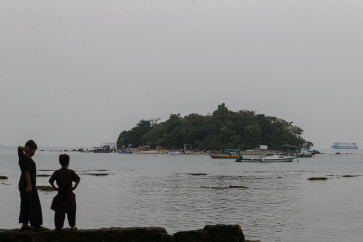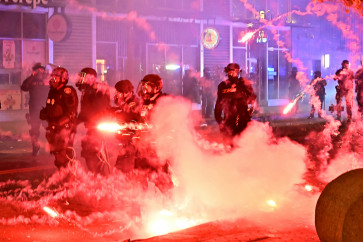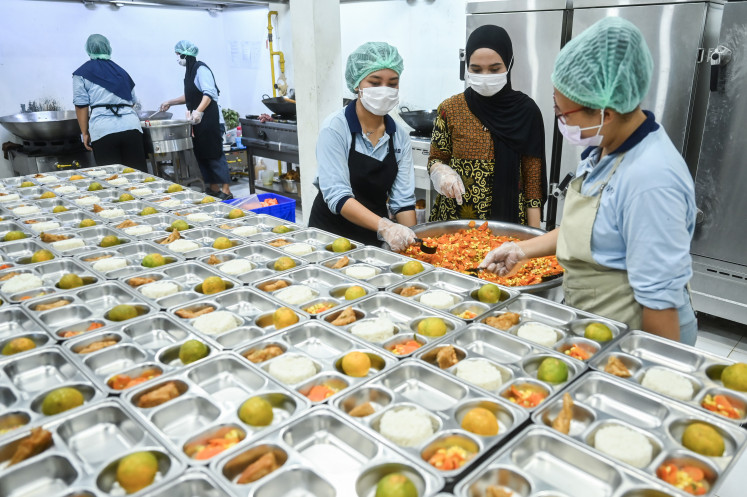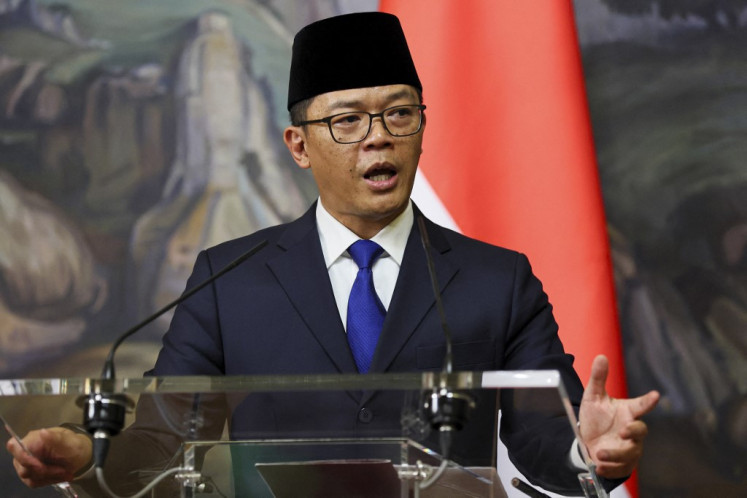Popular Reads
Top Results
Can't find what you're looking for?
View all search resultsPopular Reads
Top Results
Can't find what you're looking for?
View all search resultsHarwati: The woman ojek driver of Porong
JP/Hans David TampubolonAs the mudflow expands to more villages and lands in Sidoarjo, East Java, residents in the Porong subdistrict are doing whatever it takes to survive another day
Change text size
Gift Premium Articles
to Anyone

JP/Hans David Tampubolon
As
the mudflow expands to more villages and lands in Sidoarjo, East Java,
residents in the Porong subdistrict are doing whatever it takes to
survive another day.
Most residents who were once farmers and
factory workers are now working as motorcycle taxi drivers (ojek). While
most of them are men, at least one woman has been forced to take the
job in one of the world’s most dangerous disaster settings.
Harwati
had donned a dusty blue sweater and black trousers when The Jakarta
Post interviewed her. She kept her hair tied up. She looked straight
into the interviewers’ eyes as she spoke and she held nothing back of
her struggles and neglected residents in Porong.
“I have been an
ojek driver for around the last six years,” Harwati said, meaning that
she took the job shortly after the mud first erupted in May 2006.
“Before
the mudflow erupted, I was a housewife and I had a convenience store.
Life was very good. It was not lavish but good enough for us to get by,”
she added.
Then on May 2006, everything changed for Harwati, her
family and the residents of Porong in general. On May 29 of that year,
PT Lapindo Brantas conducted drilling nearby the area and the first
mudflow eruption began to take place.
The company and the
government tried various methods to stop the flow, with the help of
various scientists from inside and outside the country. Yet the mudflow
is still going strong after nearly seven years and has buried more than
600 hectares of land, displacing almost 40,000 people. It has submerged
three subdistricts, 12 villages, over 11,000 buildings and 362 hectares
of rice fields.
“When the mudflow struck, I was forced to
evacuate to a shelter. Along with my husband, parents and children, I
stayed at the camp for nine months,” Harwati said.
Staying in the
camp exposed Harwati and her family to the air and water that had been
polluted by the mudflow. Within months, Harwati’s husband, Muhtadi,
developed cancer and died in 2007, she said.
“My husband’s death
forced me to become an ojek. I first tried to look for work at
factories but nobody wanted to hire a 37-year-old woman. I couldn’t
compete with younger people for factory jobs,” Harwati said.
On her first day as an ojek driver, she admitted she could not even drive a motorcycle properly.
“I
knew the theory and concept of riding a motorcycle, but I had never
done it. Fortunately, my fellow drivers have all been very supportive
even though I’m a woman. They taught me how to ride a motorcycle and
they were always willing to help me if I had a minor accident,” she
said.
Harwati now earns around Rp 500,000 (US$51.56) per month, a
lot less than what she used to earn as a convenience store owner but
enough to finance her parents and the schooling of her two daughters —
Dian Kahrina Maharani and Khatrina Maharani.
“I’m still waiting for the remains of my compensation payment. Once I receive it, I’ll be moving to a better place,” she said.
Under
Presidential Regulation no.14/2007, Lapindo should compensate residents
in the area by buying their properties in two separate payments. First,
Lapindo should pay residents 20 percent of the property values and the
rest of the payment should be completed within two years.
In
2009, however, the Supreme Court ruled that the mudflow was a natural
disaster and Lapindo, partially owned by the Bakrie family, had no
obligation to pay compensation. Despite this, Aburizal Bakrie, the
patron of the Bakrie family and the chairman of the Golkar Party,
promised to fully pay residents by buying their land, saying it was his
late mother’s last wish.
But the Bakrie group and family
representatives have said they are still trying to fulfill their
commitment, forcing people yet to receive full compensation to stay in
the area, even though it has practically become a ghost town with only a
few businesses and jobs available.
Harwati said that her
experience had made her question whether the state still considered the
Porong residents as Indonesian citizens.
“Some of us have been
compensated using the state budget while some have not received full
compensation, because their properties are located in the affected
zone,” she said, meaning that they are only entitled to be paid by
Lapindo or the Bakrie group.
“I often wonder, are we, the
residents of Porong, divided into two citizenship groups? Those who
belong to Indonesia and those who belong to Lapindo?” she asked.









